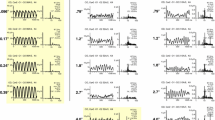Abstract
· Background: If visual acuity (VA) and/or visual field (VF) is claimed to be worse than in reality, it can be difficult to estimate the actual VA/VF. This paper describes a method of proving malingering and of estimating the actual VA by statistical evaluation of the subjective responses to discrete visual stimuli. · Methods: VA is measured by using a Landolt or Snellen optotype with four possible directions. There are n (≥16) questions at each acuity level. Each direction of the optotype occurs with the same frequency. The sequence is not predictable. In testing the VF, the stimulus is presented in an unpredictable sequence but with the same frequency at each of four distinct locations outside the claimed field at the horizontal and the vertical meridian. The field is divided into four quadrants defined by the 45°–225° and 135°–315° meridians. The candidate is requested to search for the light. The target quadrant of the first eye movement is recorded. At each VA level, the distribution function of the binomial formula allows estimation of the probability P c of ≤k c and ≥k c correct answers to n questions by mere accident. Regarding the VF, the direction of the first saccade at each stimulus presentation can be processed accordingly. · Results: If n=32 and k c=0,1,2, the chance P that this pattern is merely accidental is about 0.0001, 0.001, 0.007. Values of P≤0.01 strongly suggest that the answers were voluntarily wrong. Preference for the opposite direction can also point to psychogenic influence: If k o=15,16,17,18, P is about 0.006, 0.002, 0.0006, 0.0002. · Conclusion: Systematically false statements can yield valuable information about the actual visual functions.
Similar content being viewed by others
Author information
Authors and Affiliations
Additional information
Received: 2 October 1997 Revised version received: 5 February 1998 Accepted: 17 March 1998
Rights and permissions
About this article
Cite this article
Gräf, M. Information from false statements concerning visual acuity and visual field in cases of psychogenic visual impairment. Graefe's Arch Clin Exp Ophthalmol 237, 16–20 (1999). https://doi.org/10.1007/s004170050188
Issue Date:
DOI: https://doi.org/10.1007/s004170050188




